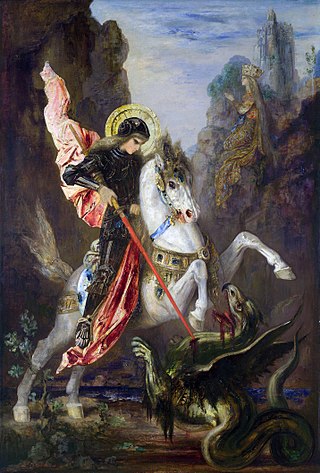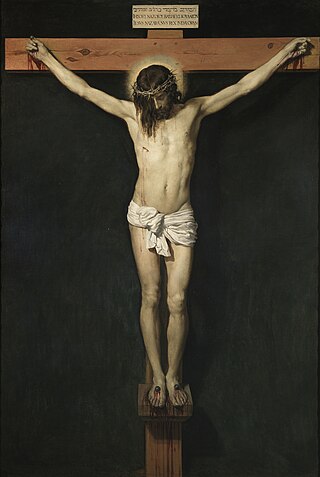
Christian mythology is the body of myths associated with Christianity. The term encompasses a broad variety of legends and narratives, especially those considered sacred narratives. Mythological themes and elements occur throughout Christian literature, including recurring myths such as ascending a mountain, the axis mundi, myths of combat, descent into the Underworld, accounts of a dying-and-rising god, a flood myth, stories about the founding of a tribe or city, and myths about great heroes of the past, paradises, and self-sacrifice.

Mere Christianity is a Christian apologetical book by the British author C. S. Lewis. It was adapted from a series of BBC radio talks made between 1941 and 1944, originally published as three separate volumes: Broadcast Talks (1942), Christian Behaviour (1943), and Beyond Personality (1944). The book consists of four parts: the first presents Lewis's arguments for the existence of God; the second contains his defence of Christian theology, including his notable "Liar, lunatic, or Lord" trilemma; the third has him exploring Christian ethics, among which are cardinal and theological virtues; in the final, he writes on the Christian conception of God.
Religion and mythology differ in scope but have overlapping aspects. Both are systems of concepts that are of high importance to a certain community, making statements concerning the supernatural or sacred. Generally, mythology is considered one component or aspect of religion. Religion is the broader term: besides mythological aspects, it includes aspects of ritual, morality, theology, and mystical experience. A given mythology is almost always associated with a certain religion such as Greek mythology with Ancient Greek religion. Disconnected from its religious system, a myth may lose its immediate relevance to the community and evolve—away from sacred importance—into a legend or folktale.
George Albert Wells was an English scholar who served as Professor of German at Birkbeck, University of London. After writing books about famous European intellectuals, such as Johann Gottfried Herder and Franz Grillparzer, he turned to the study of the historicity of Jesus, starting with his book The Jesus of the Early Christians in 1971. He is best known as an advocate of the thesis that Jesus is essentially a mythical rather than a historical figure, a theory that was pioneered by German biblical scholars such as Bruno Bauer and Arthur Drews.

In Christianity, Jesus is believed to be the Son of God as written in the Bible's New Testament, and in mainstream Christian denominations he is God the Son, a person of the Trinity of God.

Karl Rahner was a German Jesuit priest and theologian who, alongside Henri de Lubac, Hans Urs von Balthasar, and Yves Congar, is considered to be one of the most influential Catholic theologians of the 20th century. He was the brother of Hugo Rahner, also a Jesuit scholar.

Pauline Christianity or Pauline theology, otherwise referred to as Gentile Christianity, is the theology and form of Christianity which developed from the beliefs and doctrines espoused by the Hellenistic-Jewish Apostle Paul through his writings and those New Testament writings traditionally attributed to him. Paul's beliefs were rooted in the earliest Jewish Christianity, but they deviated from this Jewish Christianity in their emphasis on inclusion of the Gentiles into God's New Covenant and in his rejection of circumcision as an unnecessary token of upholding the Mosaic Law.

Most scholars who study the historical Jesus and early Christianity believe that the canonical gospels and the life of Jesus must be viewed within their historical and cultural context, rather than purely in terms of Christian orthodoxy. They look at Second Temple Judaism, the tensions, trends, and changes in the region under the influence of Hellenism and the Roman occupation, and the Jewish factions of the time, seeing Jesus as a Jew in this environment; and the written New Testament as arising from a period of oral gospel traditions after his death.

The miracles of Jesus are miraculous deeds attributed to Jesus in Christian and Islamic texts. The majority are faith healings, exorcisms, resurrections, and control over nature.

The Christ myth theory, also known as the Jesus myth theory, Jesus mythicism, or the Jesus ahistoricity theory, is the view that the story of Jesus is a work of mythology with no historical substance. Alternatively, in terms given by Bart Ehrman paraphrasing Earl Doherty, it is the view that "the historical Jesus did not exist. Or if he did, he had virtually nothing to do with the founding of Christianity."
Criticism of Christianity has a long history which stretches back to the initial formation of the religion in the Roman Empire. Critics have challenged Christian beliefs and teachings as well as Christian actions, from the Crusades to modern terrorism. The arguments against Christianity include the suppositions that it is a faith of violence, corruption, superstition, polytheism, homophobia, bigotry, pontification, abuses of women's rights and sectarianism.

The Weight of Glory and Other Addresses is a collection of essays and addresses on Christianity by C.S. Lewis. It was first published as a single transcribed sermon, "The Weight of Glory" in 1941, appearing in the British journal, Theology, then in pamphlet form in 1942 by Society for Promoting Christian Knowledge, London. It was published in book form in 1949, as a compilation of five addresses, in London by Geoffrey Bles under the title Transposition and Other Addresses and in the U.S. by The MacMillan Company under the title The Weight of Glory and Other Addresses. A revised and expanded edition featuring four additional essays and an Introduction by Walter Hooper was published by Macmillan Publishers in 1980.

Jesus was criticised in the first century CE by the Pharisees and scribes for disobeying Mosaic Law. He was decried in Judaism as a failed Jewish messiah claimant and a false prophet by most Jewish denominations. Judaism also considers the worship of any person a form of idolatry, and rejects the claim that Jesus was divine. Some psychiatrists, religious scholars and writers explain that Jesus' family, followers and contemporaries seriously regarded him as delusional, possessed by demons, or insane.
John Dickson is an Australian author, Anglican clergyman and historian of the ancient world, largely focusing on early Christianity and Judaism. He currently teaches at the graduate school of Wheaton College (Illinois).
Lewis's trilemma is an apologetic argument traditionally used to argue for the divinity of Jesus by postulating that the only alternatives were that he was evil or mad. One version was popularised by University of Oxford literary scholar and writer C. S. Lewis in a BBC radio talk and in his writings. It is sometimes described as the "Lunatic, Liar, or Lord", or "Mad, Bad, or God" argument. It takes the form of a trilemma — a choice among three options, each of which is in some way difficult to accept.
This is a list of writings by C. S. Lewis.
The Chronicles of Narnia is a series of seven fantasy novels for children written by C. S. Lewis. It is considered a classic of children's literature and is the author's best-known work, having sold over 100 million copies in 47 languages. The series borrows characters and ideas from Classical, Norse, Irish, Arthurian, Islamic, Jewish and Christian mythology. Of all the mythologies taken into consideration, the Christian one is the most fundamental for the Narnia series, due to the themes covered.
Pheme Perkins is a Professor of Theology at Boston College, where she has been teaching since 1972. She is a nationally recognized expert on the Greco-Roman cultural setting of early Christianity, as well as the Pauline Epistles and Gnosticism.
The Gospel of Afranius is a 1995 counterapologetic polemic by Russian scientist and writer Kirill Eskov. Its illustrative novel part is a dramatic portrayal of Jesus. In this work, Eskov constructs a demythologised account of the events of the Gospels.









